Explore The Jetavanaramaya In Sri Lanka For A Soulful Retreat In 2025
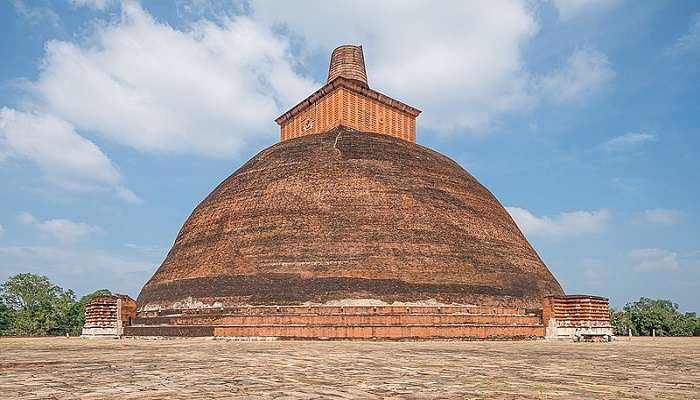
Cultural diversity, a rich archaeological landscape and a beautiful collection of Stupas. These might sound like the elements of a tough puzzle. But relate them all to Sri Lanka, and you will have a clear picture. This tiny island country is not just beautiful but culturally rich, too. You will love the warm locals, exquisite cuisines, simple lifestyle and natural wonders here. But out of all these, you will fall in love with the age-old Stupas in the lands of Lanka, as these represent the culture here. This blog will look at one such iconic temple- Jetavanaramaya in Sri Lanka.
Overview Of Jetavanaramaya In Sri Lanka
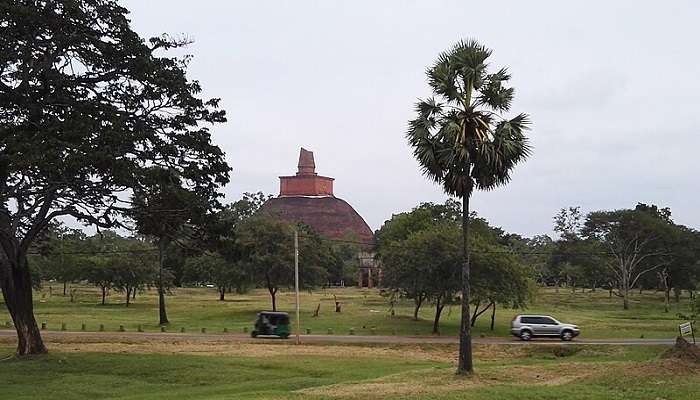
The Jetavanaramaya stupa is a Buddhist reliquary monument situated among the ruins of the Jetavana monastery in Anuradhapura, Sri Lanka, a UNESCO World Heritage Site. When it was constructed by King Mahasena of Anuradhapura (273–301), it stood at 122 metres (400 feet) and was the tallest stupa in the world. It was only surpassed by the Great Pyramid of Giza and the Pyramid of Khafre as the highest structures in the world. After his son Kithsirimevan finished building the stupa, Parakramabahu I of Polonnaruwa repaired it. The relic housed here is thought to be a portion of a belt that the Buddha knotted.
The structure is significant to the history of Sri Lanka because it symbolises the conflicts between the Theravada and Mahayana schools of Buddhism. It is also significant because it is one of the oldest buildings in recorded history and the tallest non-pyramidal structure. The stupa’s height was 122 metres (400 feet), making it the oldest in recorded history. The stupa and others were buried beneath the jungle when the Anuradhapura monarchy was destroyed and abandoned in the eleventh century. In an attempt to restore this stupa in the twelfth century, King Parakramabahu restored it to a height that is now lower than it was originally. It is currently 71 metres (233 feet) high.
Also Read: Fort Hammenhiel Jaffna
Complex Features
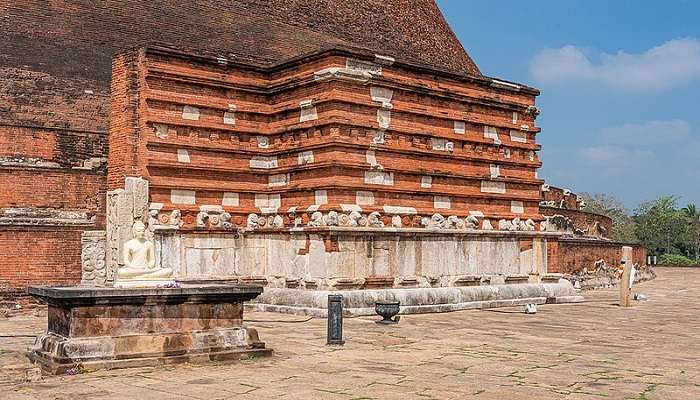
The entire complex is large and used to be the home of ten thousand Buddhist monks. The area of the land here is around 5.6 hectare. The stupa has four sides, each nine metres (28 feet) wide and one side 176 metres (576 feet) long. The shrine’s doorpost, which is 8 metres (27 feet) high, is located in the courtyard. The stupa rests on bedrock and has a base 8.5 metres (28 feet) deep.
With a base area of 233,000 m² (2,508,000 sq ft), the structure is still the largest, even though it is no longer the highest. Its construction required over 93.3 million baked bricks, and the engineering creativity involved in its creation represents a major turning point in Srilankan history. Today, Jetavanaramaya, Sri Lanka, is a popular destination for visitors due to its listing on the UNESCO heritage sites list.
History Of Jetavanaramaya Sri Lanka
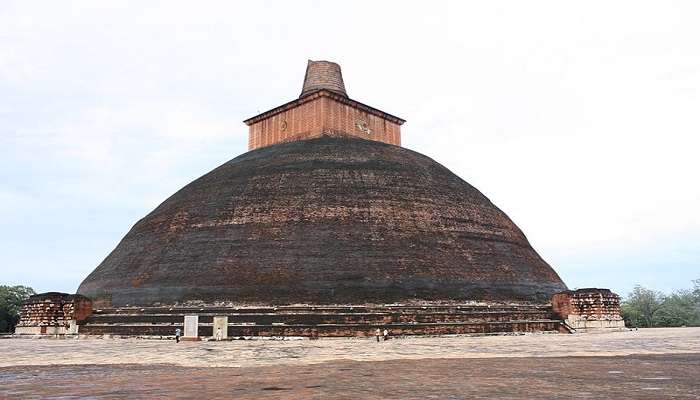
An interesting story is associated with the establishment of Jetavanaramaya, Sri Lanka. It is believed that Sanghamitra, a Mahayana monk, crowned his brother Mahasena king after King Jettha Tissa’s death. King Mahasena launched an offensive against the Theravadins who lived in the Mahavihara. The disparities between the Mahayanins and Theravadins became so great that it was declared unlawful for anyone to give alms to monks living in the Mahavihara. Eventually, the Mahavihara was abandoned. After the monks living there relocated to Malaya and the Principality of Ruhuna, Sanghamitra and Minister Sona pillaged Mahavihara and took all the treasures to Abhayagiri vihāra.
Minister Meghavannabhaya gathered an army from Malaya and camped near the Duratissaka tank in rebellion due to the looting. The night before the war, King Mahasena marched an army to meet Minister Meghavannabhaya and conducted discussions. On the grounds of Mahavihara, the king promised to erect a vihara and expressed regret for the pillaging. The king is quoted in the Mahavamsa as saying, “Pardon my fault; we will make the vihara to be dwelt in yet again.” Under the orders of the king’s wife, a labourer killed Sanghamitra. Monks returned to the Mahavihara site after the death of Sangamitra, and a Pariveda building was offered by minister Meghavannabhaya. As a result, work on Jetavanaramaya started and was offered to the monk Tissa.
Related Post: Abhayagiri Vihara
Architecture And Design Of Jetavanaramaya Sri Lanka
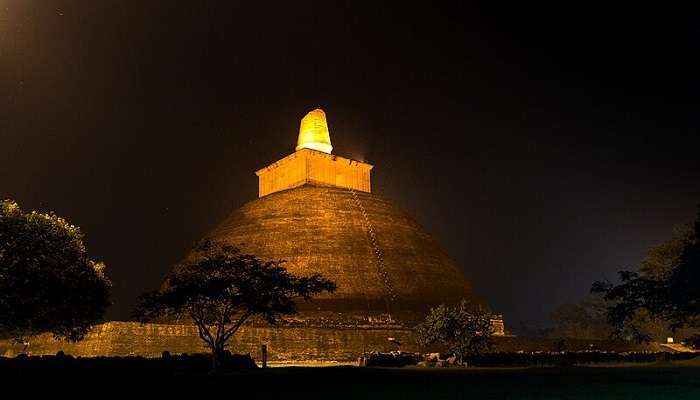
Given the fact that it is the world’s tallest ancient structure and the largest ancient stupa ever built (citation needed), the engineering prowess and structural creativity used in its construction are noteworthy. Because of the structure’s size and 8.5-metre-deep base, bricks with a maximum load capacity of 166 kg are used in construction. The enormous building could be built because of the perfect ellipsoid’s unusual shape, which allowed for stress and permitted the dome’s construction to be made of full and half bricks with earth fill. The sturdy foundation was built on bedrock. The ancient relics tell about the laying of the foundation, wherein stone-filled cracks were pressed down by elephants with leather bindings protecting their feet. The bricks employed in the construction of Jetavanaramaya were a considerable advancement in ancient Sri Lankan engineering. These were composed of 35% clay and 60% fine sand and were capable of withstanding 44 kg/cm2 (281 kg/in2).
Brick bonding materials included sieved sand, clay, limestone and finely crushed dolomite. Because the clay used was malleable, movement inside the structure was accommodated. One of the brick’s surfaces was roughened to capture the bonding slurry and prevent lateral movement. After that, the stupa was covered in lime plaster, including stones, sand, clay, egg whites, sugar syrup, glues, oils and plant resin. The structure was waterproofed as well by the plaster. In order to keep insects and plants out of the stupa, the Mahavamsa also describes the usage of copper sheets over the foundation and arsenic dissolved in sesame oil. Jetavanaramaya Sri Lanka is thought to have taken fifteen years to finish, requiring hundreds of skilled labourers, including stonemasons, bricklayers and labourers from brickyards.
Things to See
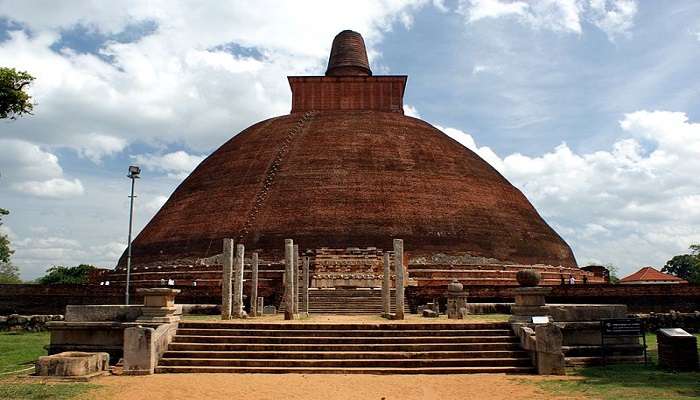
There is a museum built inside the complex. The Jetavana Museum is home to a variety of objects ranging in date from the last quarter of the third century BC to the second century BC. The majority of these items include guard stones, jewellery, ear decorations, ivory carvings, bangles, ceramics, a three-tiered urinal pot, precious stones, imported and local ceramics, more than 300,000 beads made of different materials, objects used in Hindu and Buddhist rituals, Roman and Indian coins and painted stone slabs. All of these were found during the excavation. The stunning Buddhist railing, a rectangular structure with four entrances in each of the four cardinal directions, is located behind the museum.
A vaulted Image House, the largest of its sort in Anuradhapura and the Polonnaruwa Era, stands west of the stupa. This picture house is attributed to King Sena I of Anuradhapura, who ruled from 846 to 866 CE. The picture house’s monolithic entryway stood 8.3 metres (27 feet) tall, while the structure itself was 15.25 metres in height. A large Buddha statue used to be ensconced in this image house, according to a lotus base discovered inside the chamber. The enormous Buddha statue within the image house was destroyed by the Chola conquerors. Within the monastery complex are also the chapter house, a refectory, the dwelling quarters for the monks and the cremation chamber of Mahinda Maha Thero.
You May Also Like To Read: Hotels In Embilipitiya
So there you have it, everything about the Jetavanaramaya Sri Lanka. From timings and location to historical importance and archeological significance, we have covered everything in this blog. Since reading is done, why not experience the beauty of this temple yourself? Book a trip to Sri Lanka to immerse in the breathtaking beauty of the Jetavanaramaya Sri Lanka.
For our editorial codes of conduct and copyright disclaimer, please click here.
Cover Image Credit: A.Savin for Wikimedia Commons
Frequently Asked Questions About Jetavanaramaya Sri Lanka
What are the timings of Jetavanaramaya Sri Lanka?
The Jetavanaramaya Sri Lanka opens at 8 am and closes at around 5pm. It is open every day.
What is the Jetavanaramaya Location?
The temple is located in the archeological city of Sri Lanka, called Anuradhapura. The city is located in the North Province of the island country.
What makes Jetavanaramaya Sri Lanka Famous?
he complex is one of the largest man made structures in the world. It houses a museum and various artefacts were found here during excavation.
How tall is Jetavanaramaya Sri Lanka?
The stupa is around 400 ft or 122 metres in height.
Which is the biggest Stupa in Sri Lanka?
The Jetavana is the largest stupa in Sri Lanka. It has a diameter of around 112 metres. The height of this stupa is around 71 metres. It is an ancient stupa and is one of the most visited archeological sites in the world.
People Also Read:
Most Beautiful Places In Sri Lanka Things To Do In Sri Lanka Sri Lanka Tourist Places

Innovative Content Writer Focused on Producing High quality, Original Content that drives traffic and engages readers. Experienced in Content strategy and analytics to measure content performance using tools such as SQL, Power BI, Excel.











